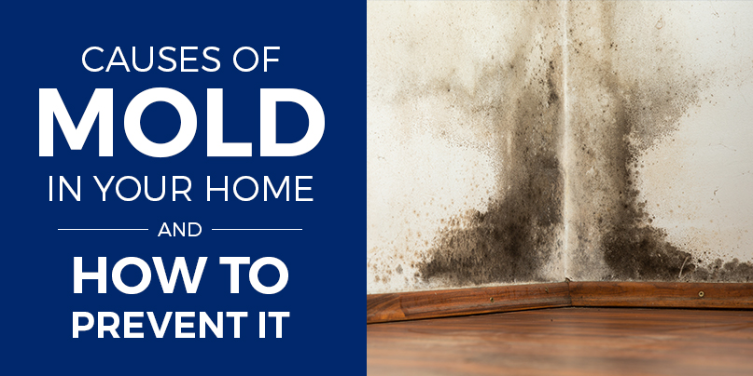
Table of Contents
- What Are Mold and Mildew?
- What Are the Causes of Mold?
- What Are the Moisture Sources in Homes?
- What Are the Signs and Symptoms of a Mold Problem?
- What Are Some Mold Remediation Actions?
- What Are Some Mold Prevention Tips?
The last thing you want is a house full of mold. But you can’t stop it. No matter how clean you keep your home, it will always contain invisible mold spores. Disinfectants can only do so much because these tiny fungi seeds are an ever-present part of nature’s recycling system. And they fulfill a necessary, vital part of decomposing organic material.
It’s when fungi spore cultures become colonies of slimy, dark mold that things get messy. They get dangerous as well. Intolerance to pathogenic mycotoxins that mold cultures emit causes serious health problems for many people. For some, it can be a permanent disability or even premature death.
While it’s impossible to entirely eradicate the presence of microscopic mold spores from your house, you certainly can prevent mold in your home. The key is controlling indoor moisture. Mold troubles most often come from high humidity, uncontrolled condensation, and simple and slow plumbing leaks. But there’s far more to knowing how to prevent mold damage than calling a plumber.
A plumber is an excellent professional resource who can fix a relatively small water leak before it turns into a giant mold problem. Plumbers are also trained to spot the telltale signs of hidden mold issues and alert you to potential disasters. A plumber’s experience is invaluable as part of mold identification. They can also be priceless in helping with mold prevention.
The first part of knowing how to prevent mold in homes is knowing the causes. Then it’s helpful to know the ramifications of letting a small area of mold contamination spread into a huge and expensive infestation. Learning what mold is, its causes, and how to properly clean moldy surfaces should be part of your home-owning education — so should watching for potential mold trouble spots. You also need to know mold’s health hazard symptoms, the safety precautions in handling moldy materials, and your insurance policy implications when it comes to mold damage claims.
Knowing the causes and prevention of mold in your home is a serious subject. Allowing mold to culture and prosper in your home can be extremely costly in both financial and health terms. Now, in the twenty-first century, mold is recognized as a previously little-known national health threat similar to what asbestos became in the twentieth century. In fact, in the bestselling book “What Every Home Owner Needs To Know About Mold and What to Do About It” by recognized mold expert Vicki Lankarge, mold is called “the asbestos of the new millennium.”
If you’re wondering how to prevent mold in your home, you’ll also be wondering about the enormous impact uncontrolled mold can have in your home. Ultimately, it’s your responsibility as a homeowner to recognize potential problems before they begin and understand the simple techniques for how to prevent mold damage.
While problems can start with something as simple as mold from a water leak in your ceiling or something as major as a flooded basement, all mold damage happens because mold behaves according to nature’s design. Let’s take a look at what mold actually is before we discuss how to prevent mold and mildew from taking hold in your home.
What Are Mold and Mildew?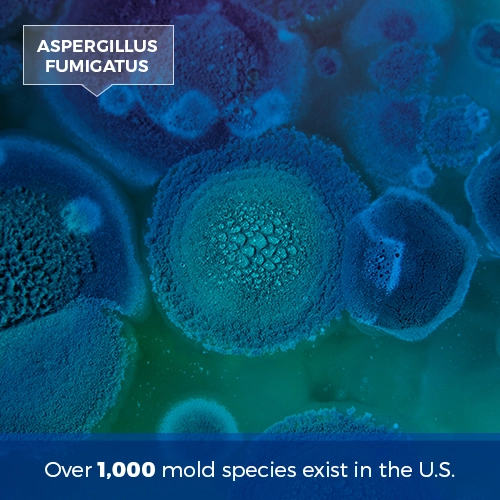
Mold is not a plant or an animal. Mold is a microscopic organism that’s part of the fungi kingdom. It occurs in every warm part of the world where there’s a moist environment. The exact number of different mold species is unknown, but scientists estimate that over 100,000 different types of mold microorganisms exist. Statistics from the Center for Disease Control (CDC) in Atlanta report that at least 1,000 species of mold are common in the United States.
Mold is a natural part of all environments where other oxygen-dependent organisms thrive. You’re exposed to mold every day. Outdoors, mold plays an important role in breaking down cellular matter and allowing it to decay as part of the decomposition process. Soil enrichment wouldn’t occur without mold. Typically, fallen trees and dead leaves turn moldy within days, especially when light is limited and air is plentiful.
Indoors, mold acts much the same way. According to the United States Environmental Protection Agency (EPA) in their informative publication “A Brief Guide to Mold, Moisture and Your Home,” mold can take hold within 24 to 48 hours after a warm enclosed area like a bathroom wall becomes wet. It can colonize within a week and spread immediately.
Mold produces various enzymes that allow it to decompose and digest organic foods. When mold multiplies, it creates cells called spores that easily spread. Spores allow mold to quickly reproduce. These tiny spores thrive in warm, wet, and low-light conditions where they have a ready food source like wood and sheetrock. Their favorite is cellulose materials. Mold can also be culture on non-organic surfaces such as shower curtains, tile, plastic, and insulation.
Mold spreads in different ways. Most lightweight mold spores become airborne and float about an environment like your basement or crawlspace. They're driven by currents from crossflow ventilation or forced by contaminated furnace ducts. Heavier spores from mold species like Stachybotrys chartarum, or toxic black mold, rely on physical transfer such as flood waters or installing previously contaminated materials.
There’s little difference between mold and mildew. Biologically, you can say they’re both fungi cousins, but a better description is more like their being at different phases of development. The term “mold” is associated with the bumpy green, brown or black films and fuzzy cultures that thrive on damp and dark surfaces. “Mildew” generally refers to the silver-gray, flat-lying mold species commonly seen as “powdery mildew” on plant leaves.
Regardless of the technical terms, the main difference is that mold can survive in dark, enclosed areas where mildew needs a certain amount of light to prosper. Mold is more destructive than mildew and is harder to identify and eradicate. Both mildew and mold respond the same way to treatment, and both can be similarly prevented before they cause structural damage or present a threatening health hazard.
It’s the causes of mold that are most important to know to prevent it from taking hold.
What Are the Types of Mold & Mildew?
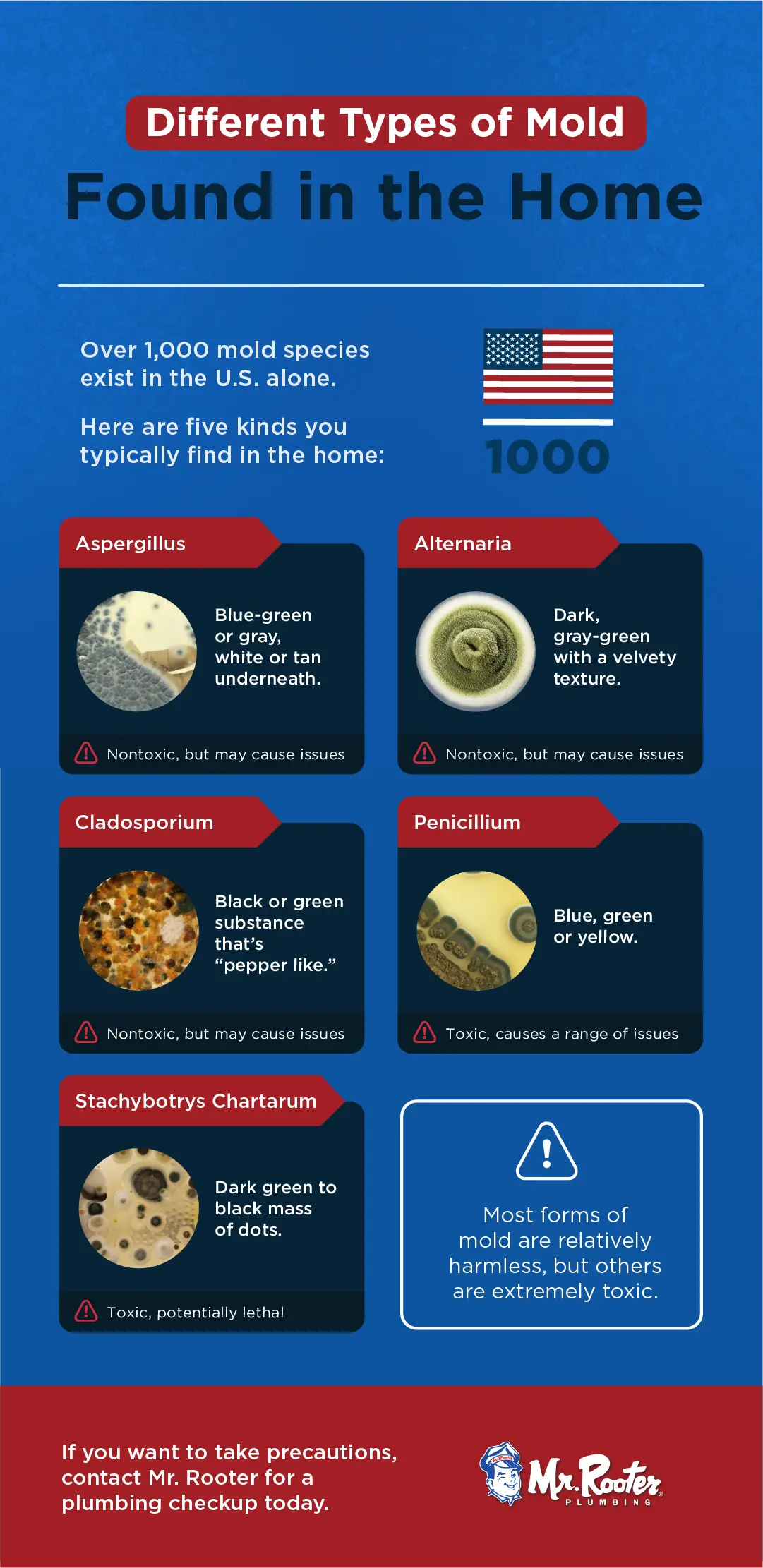
What Are the Causes of Mold?

Mold needs six elements to grow. An omission of deficiency in any condition will result in mold cultures not being able to take hold or flourish. They will also cause a mold colony to die if one or more elements are removed after mold colonization has been established.
Reducing or removing these elements is the core strategy for preventing mold. It’s also the attack for destroying an existing mold colony. Here are the six factors that cause and contribute to a mold outbreak.
1. Mold Spores
The first element is the mold spores themselves. This is hard to prevent, as mold microorganisms are prolific and almost universally present throughout the world. Spores are invisible to the naked eye and usually enter your house from the outdoors. Air movement of spores is the most common method for spreading, followed by being introduced through contaminated materials.
Removing mold spores from your home is practically impossible. Keeping conditions under control is the only recourse you have. The only places on earth where mold cannot occur are in the deserts and the ice lands — they’re far too dry and cold. Mold also doesn’t happen in lakes or under the ocean because of the lack of air.
However, where the next five elements occur, you can be sure mold spores are there, just waiting for optimum conditions to form.
2. Moisture
Without moisture, mold cannot possibly thrive. Water is the key to all life, and mold is no exception. There is no specific water content or humidity threshold where mold cannot survive. It depends on a blend of all elements. Where it’s highly humid or even slightly damp, you can be sure it’s a potential mold nursery.
The longer wet conditions exist, the more chance there is for mold to begin its growth. Most mold in homes starts in hidden places. The common cause of dampness is a minor plumbing leak under a bathroom or kitchen sink that goes unnoticed or unattended.
Mold also starts in places you can’t even see, such as in ceilings where drips from roof leaks aren’t caught. Mold also takes foot inside walls due to escapement from water lines, drain waste, and ventilation plumbing pipes that have cracked or separated. Dampness can also happen from condensation where plumbing lines are chilled, and a high-humidity environment makes them sweat.
It doesn’t have to be standing water by any means that gives enough moisture to set mold to live. Bathrooms are notorious for containing active mold growth. Corners of showers that never completely dry are common places you’ll see small, black patches forming on grout lines. Shower curtains and door tracks are other locations where mold begins.
Moisture is the primary element necessary for mold to exist. If you remove sources of moisture, you can win your fight against mold.
3. Food Source
Because mold is a life form, it needs food to survive and reproduce. Food sources outdoors are limitless where vegetation and other organic materials abound. In forests, you can find mold everywhere from under old logs to the trunks of trees. You can find it in the soil and the grass. Mold is even present on rocks.
Your house is a different story. It’s also full of mold food you wouldn't think of. When you find mold in your bathroom vanity or a closet corner, it’s feeding off the organic materials contained in wood panels or on the wallboard. It’s also feeding on minuscule amounts of dust and dirt that are there no matter how well you clean.
Mold takes hold of all sorts of things around your home. It can feed on insulation in your attic or walls, and it can feed on the back of gypsum sheetrock. Mold eats at the surface of clothes and luggage. It consumes residue left on smooth tile surfaces and microscopic materials trapped inside porous flooring like carpets. And it loves damp cardboard, newspapers, and fabrics.
Mold also gets food from the air. Spores aren’t the only thing that’s microscopically present in the air that circulates your home and that you inhale. There are countless airborne particles mold can feed on, such as dust and pollens. The air even contains the spores of other mold species that contribute to their diet.
Removing food sources for mold is neither practical nor possible. The trick is in controlling other elements, especially the warm, dim, and moist places where mold loves to hide. That includes a supply of oxygen.
4. Oxygen Supply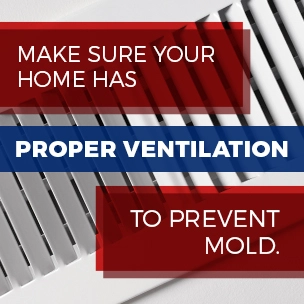
Mold can’t live without oxygen. Mold needs air to grow and reproduce. Without oxygen, mold can’t perform the organic process where it divides cells and forms mass. That includes making a steady production of spores it depends on to spread.
Air doesn’t just contribute to mold’s physical, chemical, and biological growth. Air movement is the principal carrier for mold spores so they can move locations. That spread might just be an inch or two within a tight corner, or it may well be across the floor, between rooms, or about the entire house.
Be aware that it doesn’t take large amounts of air to help mold prosper. Air is still present inside wall cavities and under insulation. Sealed boxes and closed containers still have ambient air, and it’s there to assist mold colonies in surviving. Trapped air still holds oxygen, and it doesn’t take much to allow mold to grow.
Like food sources, it’s virtually impossible to remove air in places where mold will culture. In fact, one of the best weapons in the war against mold is lots of air. Moving air through proper ventilation allows surfaces to dry through moisture evaporation that may be standing free or trapped in enclosed spaces.
It all comes back to controlling moisture, as it’s mold’s best ally in ensuring survival. That and a limited amount of sunlight.
5. Lack of Sunlight
Direct sunlight exposure is deadly to mold. The ultraviolet rays in natural sunlight destroy mold’s cellular structure. This is why you’ll only find mold outside in dim or dark places like under a forest’s canopy or on north-facing rock faces and tree trunks.
Indoor lighting doesn’t have the same devastating effect on mold. The spectrum of artificial lighting is different from sunlight and doesn’t emit the same type of photons that kill mold and stop its advancement. While mold prefers limited light or even total darkness, it still grows inside homes where incandescent or fluorescent lights are burning.
It’s not feasible to bathe your entire house in sunlight, but there are types of indoor lighting on the market that emulate the sun’s wavelengths and can destroy mold through exposure. Unfortunately, this isn’t practical or economical. Mold is going to take hold in those inevitable places where light is limited but warm and wet conditions abound. Having the right temperature makes matters more for mold to take off.
6. Optimal Temperature
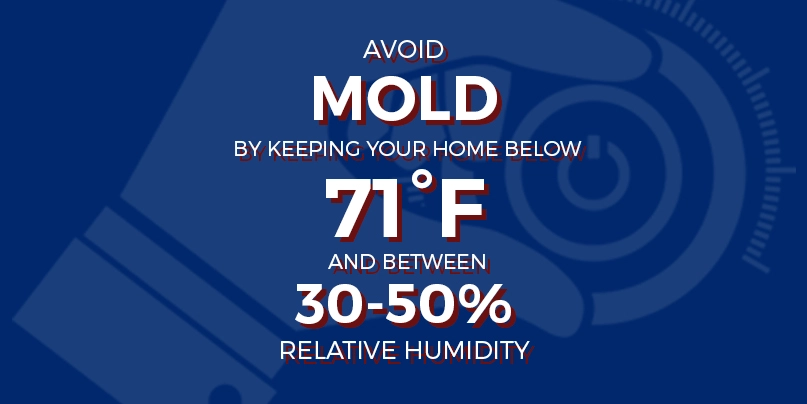
Mold doesn’t tolerate conditions that are too cold or too hot. You won’t find mold occurring in arctic regions, nor will you find it in the Sahara Desert. Freezing will destroy mold or at least make it dormant. Burning also destructs mold’s cellular structure, preventing it from growing and multiplying.
Temperature levels inside most residences are at optimum levels for mold cultures to live. Temperatures between 72 and 81 degrees Fahrenheit, or 22 to 27 degrees Celsius, are perfect for mold to grow, especially if this climate is damp and dark. Mold spores can’t take hold near the freezing point but can survive well above temperatures that are uncomfortable for humans.
Relative humidity levels are also an important factor in allowing moldy conditions. High humidity gives a wet, moist environment that encourages mold growth. The EPA recommends you keep your home between 30 and 50 percent relative humidity, with a maximum percentage being 60. Any humidity levels above that will exponentially allow mold colonization.
Regulating the temperature in your home to fight mold doesn’t really work. Although the optimum temperature is part of the six-element equation that lets mold exist, it’s a minor player compared to moisture.
If you control moisture in your home, you’re well on your way to preventing mold from ever taking hold. But that’s easier said than done, as moisture that gives mold its head start can be very hard to spot. Let’s take a tour of your home and look at the most likely places where you’ll find mold. We’ll also identify the most likely sources of that unwanted or unexpected water.
What Are the Moisture Sources in Homes?

The causes of mold are quite clear. From a scientific perspective, mold is a living organism from the fungi family that thrives in moist areas where it has water and food supply. It also prefers to be relatively warm, stay out of bright light and have an ample air supply.
Preventing mold damage in your home depends on identifying the prime places where these optimum conditions occur and then taking steps to mitigate or eradicate them. Killing mold cultures can be done with many chemical or biological treatments, but the best line of defense is removing the climates where mold begins to grow.
So what are the moisture sources in homes? In every area of your house, there’s an opportunity for mold to form. Mold spores will flourish wherever they get a chance. Reducing their odds of cultivating can come from anything like preventing or fixing a plumbing problem to making sure you have adequate ventilation.
Uncontrolled moisture is what gives optimum conditions for mold to start growing indoors. That’s usually where it’s out of sight and out of mind. Here are some of the most likely places where you’ll give mold its lucky break.
Moisture in Your Attic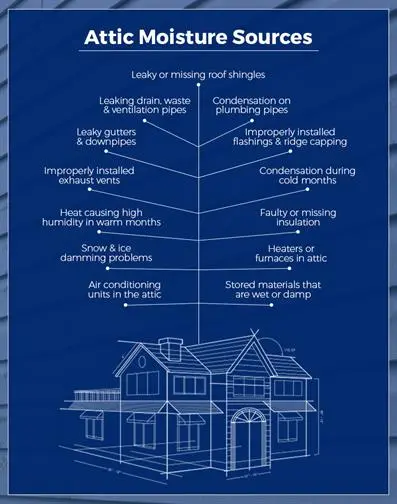
It’s common to find mold in attics, especially where there are poor ventilation and high humidity conditions. Few people spend time in their attics, particularly in today’s homes that use roof trusses instead of rafters and storage space is impractical.
Most people never enter their attic unless there’s an emergency. That’s usually due to a water leak, and by then, a mold infestation may be well advanced. Running water is easy to identify in an attic as it’s going to pour through hatch openings or from light fixtures. High humidity and moisture levels are more difficult to find. Consider these attic moisture sources:
- Leaky or missing roof shingles
- Leaking drain, waste, and ventilation pipes
- Condensation on plumbing pipes
- Leaky gutters and downpipes
- Improperly installed flashings and ridge capping
- Improperly installed exhaust vents for dryers, bath, and kitchen vents
- Condensation during cold months
- Heat causing high humidity in warm months
- Faulty or missing insulation
- Snow and ice damming problems
- Heaters or furnaces in the attic
- Air conditioning units in the attic
- Stored materials that are wet or damp
Moisture in Your Basement
If you have a full, in-ground basement, you’ve got a good breeding place for mold. Most basements are dark, fairly warm, poorly ventilated, and quite humid. They also have food sources and abundant oxygen.
Basements also contain plumbing parts like pressurized hot and cold supply lines, drain pipes, floor drains, sumps, and sometimes wells. Consider these basement sources of moisture:
- Flooding from natural or plumbing causes
- Clogged or faulty perimeter drains
- Poor or lack of exterior damp-proofing
- Sump pump failure
- Leaking plumbing pipes
- Improper drainage of exterior water from bad grading
- Cracks in foundation walls
- Dirt and dust accumulations over time
- Broken or leaky gutters and downspouts
- Poor air circulation
- Furnace duct condensation
- Drain lines from high-efficiency furnaces
- Hot water tank overflows
- Water condensation on cold surfaces
- Rain or melting snow on windows causing ingress or condensation
Moisture in Your Crawlspace
You might not have a full basement, but you’ll probably have a crawlspace under your home unless your place was built with a slab-on-grade. Confined crawlspaces contain optimum mold-growing conditions, and that’s due to ever-present moisture that’s not taken care of. Here are some common crawlspace moisture sources:
- Lack of ventilation from passive cross-flow or mechanical means
- Missing or compromised vapor barrier
- Bare earth floor with no concrete skim coat
- Leaky water lines or drain pipes
- Disconnected dryer vents that pump humid air
- Condensation in furnace ducts
- Drain lines from condensation in high-efficiency furnaces
- Rain or flood water
- Holes or cracks in foundation walls
- High-ground water tables
- Lack of insulation
- Poor exterior grading that allows water to flow against the foundation
- Poor drainage on foundation backfill
- Blocked perimeter and footing drain tiles
Moisture in Your Bathroom
Bathrooms are by far the most common rooms in your house to experience mold problems. Fortunately, they’re the easiest rooms to discover mold outbreaks in, and that’s because you’re probably looking for mold during routine cleaning.
Bathrooms are high-humidity rooms by nature of their intended use. Normal living creates high humidity from hot showers and baths. Using the sink creates moisture, as does flushing the toilet. Even standing water in the sink or plumbing traps contributes to evaporation and keeps the bathroom's relative humidity high.
Bathrooms have many surfaces where mold can start. There are plenty of places like smooth tile faces and porous grout spaces that quickly harbor mold if moisture isn’t controlled. Inside vanity cabinets is a common spot for mold to start. Another common place for mold is behind toilets where air circulation is blocked. All this is due to the presence of moisture that rises from these sources:
- General plumbing problems like leaks and overflows
- Water evaporation
- Poor ventilation, like fans or opening windows
- Frequent running water like tap drips or toilet run-ons
- Damp shower areas including shower curtains and doors
- Standing water in sinks and tubs
- Leaky drain pipes
- Condensation on cold surfaces such as toilet tanks and chrome fixtures
- Broken toilet seals
- Wet floor mats and towels
- Low heat to allow evaporation of excessive moisture
- Failed grout or caulk around shower and tub enclosures
- Water puddles on floors and in corners
- Wet tissues left in garbage cans
- Moisture drops from ceiling vent housings
Moisture in Your Kitchen
Mold is commonly found in kitchens, and that’s not surprising given how much water is used for cooking and cleaning. Kitchens are second to bathrooms as the location where the most water is contained in plumbing components. That includes water supply lines, drain pipes, sinks, dishwashers, and even ice makers.
Kitchens store passive water in pots left on counters and inside fridges. Dishes are left on the counter to dry, and kettles steam away on the stove. All this makes your kitchen a high-humidity environment that increases the odds of mold forming. Consider these moisture sources in your kitchen:
- Leaks in the dishwasher and sink supply and drain lines
- Poor range hood ventilation
- Condensation on plumbing pipes under cabinets
- Stored liquids that aren’t properly sealed
- Steam from pots, pans, and dishwashers
- Water spills
- Tap runoffs
- Standing water in sinks and pots
- Wet and humid cabinet cavities
- Poorly installed counters and backsplashes that trap water
- Spills and splashes that aren’t mopped up
Moisture in Your Heating, Ventilation, and Air-Conditioning (HVAC) System
Regardless of whether you're heating your home up or cooling it down, you’re going to be moving air that contains moisture. There are many different forms of HVAC systems and their parts. Some use water as a primary heat source, and often you’ll find homes that incorporate some form of humidifier or dehumidifier. That depends on the climate.
Most HVAC systems have ductwork that moves warm air about and cold air in return. These ducts are perfect environments for mold to form because they’re dark and warm and they have plenty of air and contain an optimum humidity level. Removing mold from ductwork can be a terrible chore.
Ductwork is also the place where airborne debris gets trapped. That’s everything from household dust to pet hair and dander. Trapped material also locks in moisture and starts promoting a colony of mold. Here are the HVAC sources of moisture:
- Clogged and blocked air filters
- Condensation in ductwork from lack of insulation
- Condensation runoff in high-efficiency furnaces
- Condensation of metal joints and HVAC frames
- Wet fiberglass insulation
- Improper use or lack of drain pans
- Saturated air coming from HVAC condensers
- Improper blend of indoor and outdoor air
- Damaged or missing foil wrap on ducts
- Weak or no airflow from grilles and registers
- Leaks at duct joints
- Faulty thermostats and fan controls
Moisture on Your Home’s Exterior
Inside your home is not the only place to be worried about mold. It happens outside as well and can present considerable mold damage. Exterior environments around your home are an extension of nature. There are all the elements of mold spores everywhere, along with favorable temperatures, oxygen, light levels, food, and, of course, moisture.
Moisture is much harder to control outdoors than in. Your home’s exterior is designed to repel nature’s forces. That includes water hammering at your home from rain, wind, snow, ice, and sweltering humidity in the heat of summer.
Sunlight is the savior of outdoor mold. Bright sunlight won’t allow mold to take a grip on your siding or fascia except for dark areas and also on the north side. These are the places to watch out for mold. They're also the locations to control moisture. Some of the main outdoor moisture culprits are:
- Rainwater on exposed walls
- Blocked perimeter drains
- Standing water on ground and roof surfaces
- Leaky downspouts and blocked gutters
- Broken or leaky hose bibs and hose connectors
- Water wicking from vegetation planted too close to the building
- Articles placed against the building trap water and prevent evaporation
- Poor ventilation or blocked eaves
- Porous siding materials like stucco and brick
- Improper grading that allows water to slope toward the foundation
- Incorrectly placed lawn sprinklers that spray house walls
- Large overhangs that shade walls and prevent sunlight exposure
- Warm areas like duct and dryer vents
- Garages where cold, wet vehicles enter while engines and exhausts are warm
With so many sources of moisture to control inside and outside your home, it’s no wonder infestations of mold happen from time to time. Plumbing leaks and blocked drains are the main reasons for mold-related house problems. That’s because many plumbing problems begin as minor drips or blocks and go undetected until they produce symptoms you can’t ignore.
Unfortunately, by the time you notice the signs, the damage is done. A thriving mold situation may be well in motion. Here are some of the main signs and symptoms to look for that indicate you’ve got a mold problem in your home.
What Are the Signs and Symptoms of a Mold Problem?
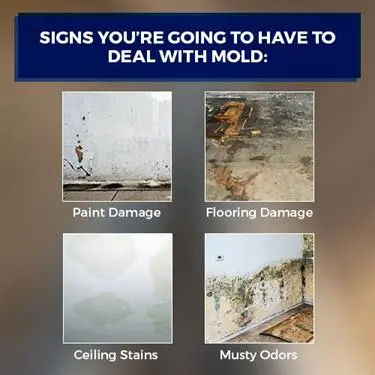 The initial signs and symptoms of having a mold infestation will come to your senses. First, you’ll likely see something unusual like stains or discoloration. Next, you’re apt to notice a musty smell that’s a sure giveaway of mold lurking nearby.
The initial signs and symptoms of having a mold infestation will come to your senses. First, you’ll likely see something unusual like stains or discoloration. Next, you’re apt to notice a musty smell that’s a sure giveaway of mold lurking nearby.
Here are some subtle but sure signs that you’re going to have to deal with mold.
- Damage to paint or wallpaper. Mold often colonizes inside wall cavities where its elements are favorable. Once mold takes hold of the wallboard or paneling, it causes the materials to decay and separate. This is a clear sign that the mold colony is active and well-established.
- Damage to flooring. Mold easily breeds under flooring and in joist cavities. In fact, the usual places to spot mold are lower down where gravity has pulled and pooled water. You might see linoleum or sheet flooring discoloring or lifting. There might be stains on carpets or lifting of hardwood floors.
- Stains on ceilings. Many times, mold will form in attics or between floors where it will leave evidence below it such as staining on the ceiling. Any evidence of water damage to a ceiling is likely going to be accompanied by mold. If it isn’t already, mold is sure to follow.
- Odors in enclosed areas. If you open a closet or crawlspace hatch and it emits a smell like stagnant water, then it's a clear symptom that mold spores are present and active. If you catch it early, there’s time to remediate the situation before mold takes a bigger grip. The smell is an early warning sign of mold issues.
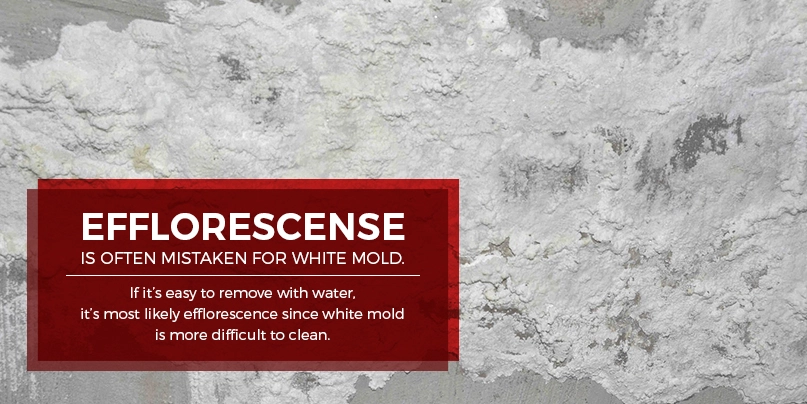
Identifying a mold problem is one thing. Remediating it is entirely another. The important thing when dealing with mold is to act on it early. Start remediation and cleanup work immediately.
Once mold takes a firm hold, it might not be possible to eradicate the mess without significant demolition and replacement of expensive materials. It might also require calling in a professional company that specializes in mold remediation.
What Are Some Mold Remediation Actions?
There are some basic actions you can take in stopping mold before it gets away. Some suggested steps 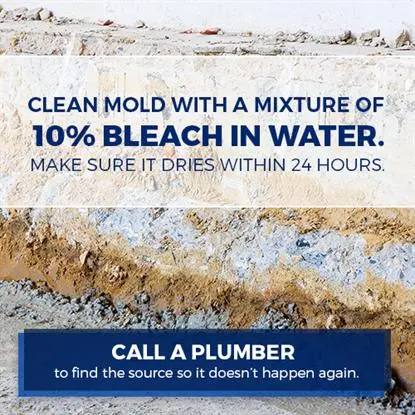 are:
are:
- Finding the source. Where there’s mold, there’s going to be water. Find the source of the water and stop it. It might require calling a plumber to fix a leaky pipe or unclog a drain, but that’s going to be inexpensive compared to letting the problem go unresolved.
- Determine the extent of mold. Find out just how big a problem you’re dealing with. The Federal Emergency Measures Agency (FEMA) has dealt with huge mold problems after natural disasters like hurricanes and floods. They recommend that any area larger than 25 square feet is too large for a homeowner to tackle. For bigger areas, call in a professional contractor.
- Dry the area. Mold cannot thrive without moisture, so make sure you get the infected area aired out and dried. Start by removing wet and contaminated material and then get the air moving. Open windows and doors or get fans in place. Moving air is the only way to efficiently dry a wet area.
- Clean and disinfect the moldy areas. Begin by washing the area with soapy water. Follow-up with a solution that kills the organisms, such as bleach cut to 10 percent with water or raw vinegar. There are many commercial products available as moldicides and mold exterminators, but they’re not more effective than bleach or vinegar.
- Discard all contaminated materials. Make sure everything like waste products and cleaning supplies are bagged and removed from your home. You can launder some of the contaminated items like clothes and towels. But when in doubt, it’s best to throw moldy materials in the garbage.
Most forms of mold are relatively harmless to humans unless you’ve had prolonged exposure or have a sensitivity like mold allergies. The exception is a black, toxic mold called Stachybotrys chartarum that can be lethal under some circumstances. Stachybotrys appears as a dark green to jet black mass of dots. If your mold colony looks like that, make sure you take personal precautions in handling this pathogen.
Recommended personal protective equipment (PPE) for handling all moldy products should include:
- Protective clothing like disposable coveralls or old clothes that can be discarded
- Dust mask — or for black mold, wear an N-95-rated respirator
- Gloves like rubber or surgical, disposable types
- Goggles that fit tightly around the eyes to guard against splash
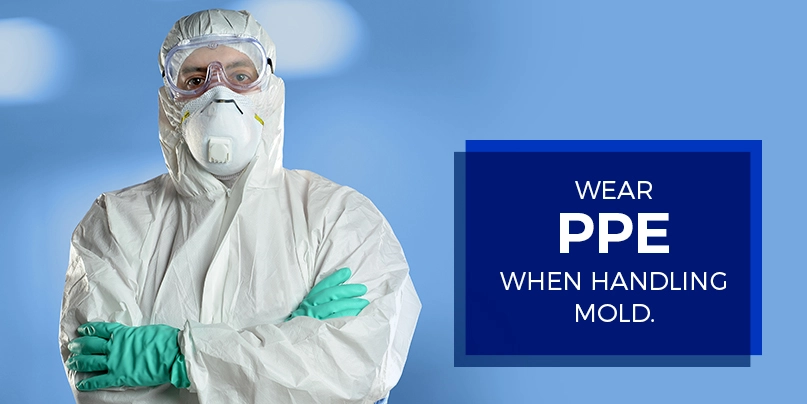
Identifying and cleaning up after experiencing a mold problem is not a pleasant experience. Despite the possible health hazards, mold remediation can be time-consuming, not to mention extremely expensive. Some mold infestations are so severe, occupants are forced to move out and then struggle with insurance companies to compensate them for repairs to the damage.
The simplest solution to any mold issue is to avoid having one. Preventing mold in homes is easy to do, provided you know what to look for and stop problems before they happen. That includes having periodic plumbing inspections or calling a plumber to fix any water leak or drainage block as soon as you suspect one.
What Are Some Mold Prevention Tips?

The best advice about dealing with mold is to get on it as soon as you suspect something’s wrong. Don’t wait until the damage is done and expensive remediation work is needed. Mold is a fast-acting organism. The EPA guide reports that mold spores can cultivate within 24 – 48 hours of finding a warm, moist place. Time is of the essence.
Here are more of the EPA’s mold prevention tips: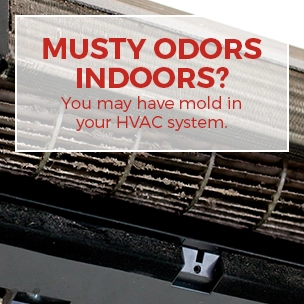
- Clean up spilled water immediately
- Insulate cold surfaces to prevent condensation
- Ensure all rooms have adequate ventilation
- Slope exterior ground away from your foundation
- Clean gutters and downpipes often
- Keep humidity levels below 60 percent
- Make sure air conditioning drains run free
- Make sure HVAC appliances are regularly serviced
- Keep bathroom and kitchen windows cracked open
- Run your fan when showering
- Watch for standing water inside and out
- Inspect your home each season for signs and smells of mold
What Other Things Should I Do to Prevent Mold?
Mold prevention is part of regular homeowner maintenance. The EPA recommends you think of mold prevention in four parts:
- Stop the water. Fix leaks as soon as they happen. Don’t hesitate to call a plumber to repair a drip or free a drain. Use them as a maintenance resource for inspections and advice.
- Keep it clean. Don’t let dirt and debris build-up, particularly in enclosed and humid areas. Air out fabrics and keep floors washed. Make sure showers, sinks, and tubs are rinsed and dried.
- Keep it dry. Reduce ambient moisture through ventilation and dehumidifiers. Reduce the opportunity for mold to grow where condensation happens from cold surfaces. Insulate them and keep your home dry.
- Disinfect it. Make sure you kill any evidence of mold before it expands. Routinely check areas that present potential problems, and don’t be afraid to use a bleach solution or plain old vinegar.
Educating yourself about the signs and symptoms of mold is one of the best preventative actions you can take. There is plenty of information available online. Another excellent source is your local plumbing professional, who is an expert on the causes of mold and how to prevent it.
Mr. Rooter Plumbing of Greater Syracuse is your best choice for all plumbing leaks and problems that cause mold infestations. To prevent mold from growing in your home, contact us for a plumbing checkup.


